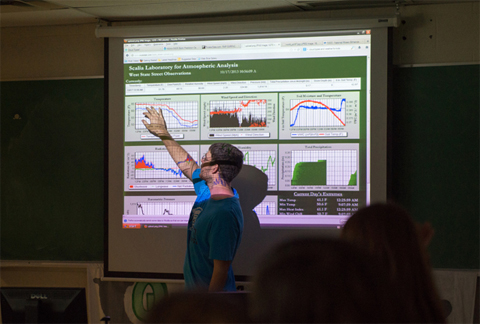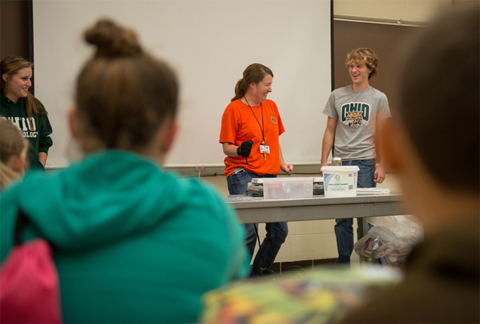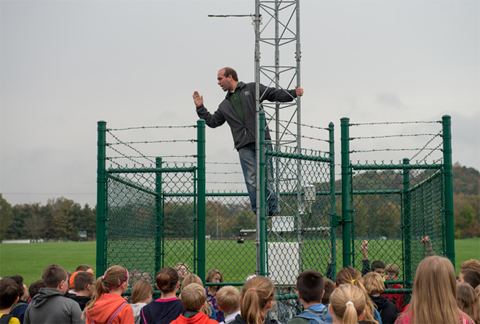By Jill Wallenhorst
from Compass
Students in the fifth-grade class at Nelsonville-York Elementary School stood within feet of a tornado in the heart of Athens, but they weren’t scared. In fact, they loved it.
The students weren’t storm chasing. They were on field trip to Ohio University’s Scalia Laboratory for Atmospheric Analysis.
A fifth-grade science teacher at Nelsonville-York Elementary School, Olivia Kittle recently tapped into the educational resources the university offers to educators in Southeast Ohio’s primary and secondary schools. Kittle brought 100 of her students to OHIO’s Athens Campus for a day full of experiments, activities and real-life lessons on weather and meteorology. The Scalia Lab is part of the Meteorology program offered through the College of Arts & Sciences Department of Geography.
“I was really pleased that OU was willing to host our students,” Kittle said. “Rather than just seeing (the information we were discussing in class) on flat slides, this was a real-life, this-is-how-it-works experience.”
Through the Ohio University chapter of the American Meteorological Society’s Meteorology Outreach Program, the Nelsonville-York students were treated to hands-on activities and presentations at multiple weather-related venues on campus.
The students’ field trip not only provided them interactive experiences that reinforced lessons learned inside their traditional classroom but also a chance to see visit a college campus and experience what Ohio University is all about.
“The fact that it’s local to us and a lot of our Nelsonville kids end up coming to OU, I wanted them to see everything available to them,” Kittle said. “Not just the experience of learning about weather, but of being on a college campus.”

Fifth graders at Nelsonville-York Elementary School listen to Dr. Ryan Fogt discuss some of the technology used at the Scalia Laboratory for Atmospheric Analysis.
Inside the Student-Run Scalia Lab
The students’ experience began at the university’s weather tower, located off West State Street, where they heard a presentation by Dr. Ryan Fogt, Assistant Professor of Meteorology and Director of the Scalia Laboratory for Atmospheric Analysis, also known simply as Scalia Lab. The students then traveled to the student-run Scalia Lab in Clippinger Laboratories. They saw how the data picked up from the weather tower is relayed directly to Scalia Lab, providing real-time conditions.
“The Scalia Lab, with the computers set up and the weather map, was great. We saw real-time footage, and connecting that to the weather tower allowed them to link it together in their minds,” Kittle said.
All that weather-related technology allows Ohio University to notify and inform the local community when weather-related emergencies occur. It also earned the university a StormReady community designation from the National Weather Service in 2011, making OHIO one of only three higher education institutions in the state to obtain the recognition.
While at Clippinger, the students also observed experiments that brought their weather-related lesson plans to life. Split into groups, the students rotated throughout three rooms, each hosting a different activity. One room hosted an experiment about air pressure in which a pop can filled with boiling water was dropped into a tub of ice, crushing the can. In the other rooms, students saw an experiment that illustrated how heat rises and observed how a tornado forms.
Planning a day in which students could engage in an interactive learning experience was easy. All Kittle had to do was contact Chad Goergens, outreach chair for the Ohio University chapter of the American Meteorological Society, to make the arrangements.
“I’ve loved meteorology since way before college,” Goergens said. “I wish I’d had something like this when I was their age.”

Kyle Clem, a graduate student at Ohio University, explains to Nelsonville-York Elementary School students how data collected from the University’s weather tower is relayed to the Scalia Laboratory for Atmospheric Analysis, which is located in Clippinger Lab on the Athens Campus.
The Nelsonville-York students were definitely pleased with the outcome of the day. Each student had a favorite activity, whether it was the air pressure experiment or the experiment that showed how a tornado formed using two 2-liter bottles filled with water.
“The tornado was my favorite part,” said Xander, one of the students. “Also I’ve never heard of a pop can crushing from just hot and cold water.”
“I thought they were fantastic,” Fogt said of his elementary school pupils. “They paid attention and asked tons of questions, and it seemed like they were really interested and excited to learn about something from people who are doing it every day.”

Students studying meteorology at Ohio University assist Nelsonville-York Elementary School teacher Olivia Kittle (center) with an experiment during her class’ recent field trip to the University.
Meteorology Students Put on the Show
What set apart this particular visit to a college campus from a typical field trip is that the elementary students were taught by other students. Ohio University meteorology students volunteered their time to come in and teach the Nelsonville-York fifth graders.
Community and citizenship are two of OHIO’s five core values and are woven into the University’s vision. A recently released Ohio University Economic Impact Study found that OHIO students engaged in more than 1.4 million hours of experiential learning and volunteer opportunities during the 2011-12 school year. The economic impact of these activities is valued at more than $25.8 million to the local, regional, state and national community.
In addition, OHIO partners with 135 school districts and educational institutions through the Coalition of Rural and Appalachian Schools (CORAS), supporting the continuous improvement of educational opportunities for public school students in Appalachian Ohio. The Nelsonville-York School District is also a member of CORAS, which is funded through membership dues and support from OHIO’s Patton College of Education.
Fogt noted that the Nelsonville-York meteorology field trip was a great opportunity for these elementary school students to learn from college students because it allowed the schoolchildren to be inspired by people they may consider role models.
“When I was younger, I was always inspired by high schoolers and college students that seemed so old to me, and I wanted to be like them,” Fogt said. “This was a great opportunity for these kids to be taught by people that they can look up to and want to be like them someday.”
Fogt said he hoped the students came away from their visit to OHIO being more aware of weather and having learned something in a deeper or new way. Judging by the students’ reactions, he achieved his goal.

Dr. Ryan Fogt, assistant professor of meteorology and director of OHIO’s Scalia Laboratory for Atmospheric Analysis, explains various weather instruments at the University’s weather tower to fifth-grade students from Nelsonville-York Elementary School. Photos by Ben Wirtz Siegel
“We’re lucky to have a school like this so close by,” said Xander. “Today gave me more knowledge about stuff I already knew by actually doing it and by making it more fun.”
This was the first meteorology field trip to Ohio University that Kittle has planned, but she plans to make it a tradition in her classroom.
“The teachers and myself have all said that we really enjoyed the day and it’s been wonderful,” she said. “We’re all very pleased.”
One of her students, Adrianna, said that she wants to go to Ohio University like her mom, an alumna, and learn more about weather. When asked why she wanted to be a Bobcat, her answer was simple: “Because it’s awesome.”



















Comments